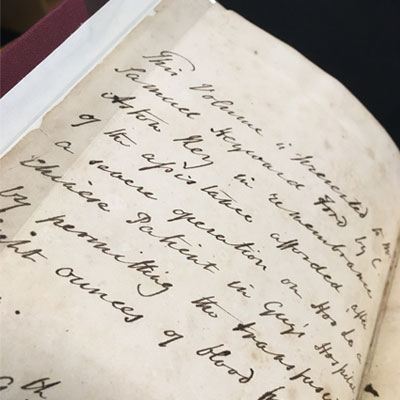In April 1831, medical student Samuel Hayward Ford went to watch an operation in the great anatomical theatre at Guy’s Hospital, London. What Samuel Ford couldn’t know as he set out that day was that he would end up being more than just a spectator.
We know Ford attended this particular operation thanks to an inscribed 1828 edition of Treatise on the blood, inflammation, and gun-shot wounds.1 Ford was part of a large audience. According to The Lancet, 680 people watched surgeon Charles Aston Key remove a 56-pound (25kg) tumour from the lower abdomen of Hoo Loo, a labourer from China.2
Performed in the era before modern anaesthetics, Key’s patient was conscious during the nearly two-hour surgery, which included rest spells so that he could recover from the “… fits of exhaustion which supervened.”2
With the tumour removed but his patient now unconscious and suffering from blood loss, Key resorted to various “remedies” to “overcome this state of collapse”, including a blood transfusion. He elected to draw eight ounces of blood for the transfusion from Samuel Ford’s arm after several students volunteered to be donors. The surgeon’s efforts, however, were in vain and Hoo Loo died without regaining consciousness.
It was for this “assistance afforded” that Key gifted John Hunter’s Treatise on the blood to Ford. A letter from Key pasted into the volume also reveals it was left at the Hospital steward’s office for the 19-year-old to collect. Originally published in 1794, it was a highly influential work on inflammation and the surgical treatment of blood vessels.
The volume is among the medical rare books from the Philson Historical Collection that feature in the latest Special Collections display “Under circumstances of doubt and difficulty”: 19th century British medical training. By delving into books students read at the time, the display explores aspects of 19th century medical training and knowledge. Some of these choice rare books belonged to early colonial doctors in New Zealand, including Ford (1811-1876), who arrived in the Bay of Islands in 1837 as resident surgeon for the Church Missionary Society.3
View the display until 19 June outside Special Collections, General Library Level G.
Jo Birks, Special Collections
References
1 Hunter, J. (1828). Treatise on the blood, inflammation, and gun-shot wounds. London: Sherwood, Gilbert and Piper.
2 (1831). Guy’s hospital. The Lancet, 16(398), pp.86-89.
3 Wright-St Clair, R.E. (2013). Historia Nunc Vivat: Medical practitioners in New Zealand 1840 to 1930. Christchurch: Cotter Medical History Trust; Church Missionary Society. (1838). New Zealand. Missionary Register, p.222. Church Missionary Society. London: L. & G. Seeley.

